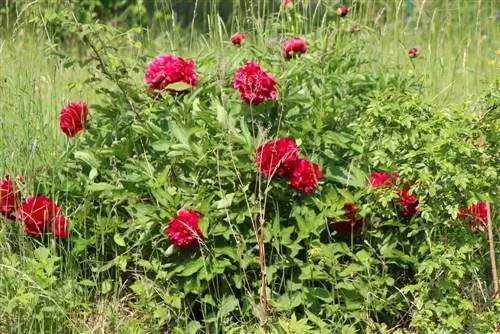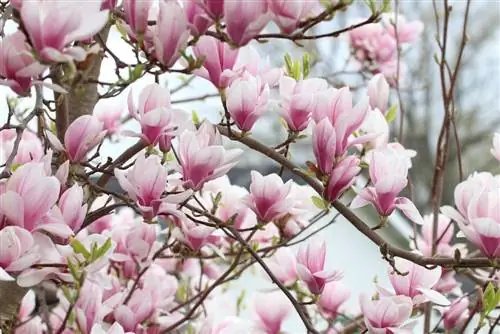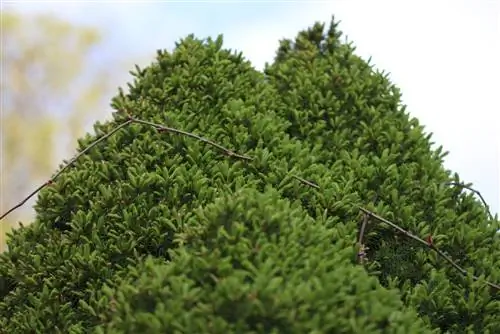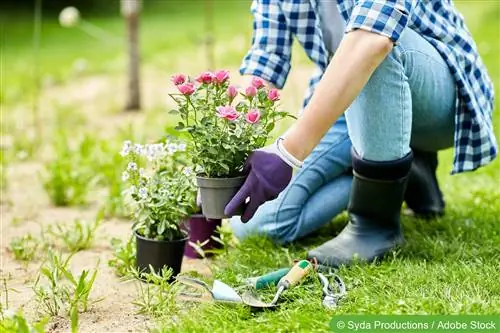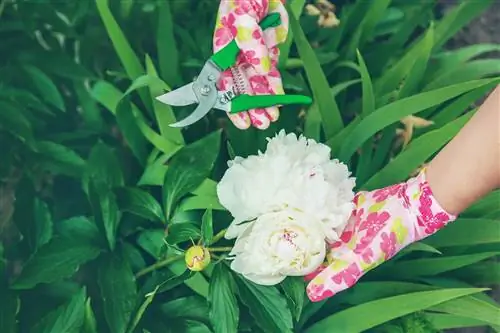- Author admin [email protected].
- Public 2023-12-17 03:39.
- Last modified 2025-01-24 12:45.
Aromatically fragrant, decorative and easy to care for - the peony is one of the most popular garden flowers in this country. Anyone who has placed the colorful plant in its optimal location and follows a few tips when caring for it can enjoy the flowers for years to come. The peony generally does not like division and transplanting; However, if you otherwise offer your crop optimal conditions, you can still carry out this process with a clear conscience.
Planting peony
When planting the peony, various aspects must be taken into account, for example:
- optimal location
- suitable substrate
- precise watering and fertilization
- targeted pruning
- careful pest control
- targeted winterization measures
If the environmental conditions are tailored to the plant, the peony can develop in its full splendor.
Optimal location
With a few exceptions, the peony requires a place in a full sun area within the green area. The plant feels particularly comfortable in the middle of the garden and at a safe distance from shady trees and bushes. If it is a shrub peony, it can also be planted in partial shade; However, it is then important that the plant can enjoy afternoon and evening sun.
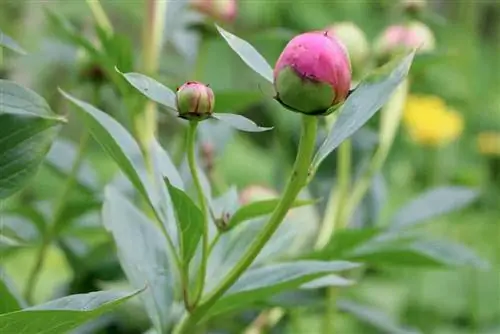
When planting, it must also be noted that the peony can reach a considerable size; Sufficient space at the chosen location is therefore particularly important. When cultivating taller varieties of perennial peony, an area of up to one meter x one meter must be planned; lower varieties require a little more than half of the open space. Tree peonies require more space; Depending on the growth, areas of up to 150x150cm must be taken into account.
Matching floor
The peony has a large root that allows it to store moisture optimally. For this reason, the plant can tolerate prolonged drought. The substrate can therefore also be slightly dry.
Note:
In the first year after planting, protection against drought is not yet fully developed, so watering must be carried out more often.
Otherwise, the ideal soil has the following properties:
- high permeability
- Clay soils are therefore suitable
- humous properties
- add sand or expanded clay to heavy soils
- Improve sandy soils with stone dust
Note:
Waterlogging must be avoided at all costs!
Careful watering
The peony can store a considerable amount of moisture in its roots; For this reason, regular watering is not necessary. Young plants need a little more water until the storage organ develops. Caution is only required in the event of persistent drought if the peony was cultivated in a location with very light and sandy soil; Then it is a good idea to water carefully before and after flowering. It is important to avoid standing water, which is why good drainage must always be considered.
Targeted fertilization
The targeted supply of selected nutrients can help the peony to develop lush flowers. However, fertilization is mainly carried out after flowering; then the plants already develop the flora for the following year. The addition of nutrients is particularly indicated if a location with a light, nutrient-poor substrate has been chosen. Then we recommend giving:
- Compost soil or
- well-rotted manure or
- Complete fertilizer with high potassium content and low nitrogen content
Tip:
While potassium promotes flower formation, too much nitrogen promotes various fungal diseases!
pruning
Tree peonies generally do not require pruning; However, it has proven to be a good idea to carry out a cleaning cut. This takes place in late autumn or in November and December. This involves cutting shoots back to the first bud, whereby most of the foliage can also be removed as a preventive measure.
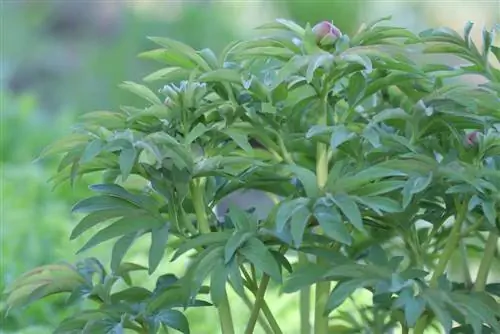
In addition, after particularly harsh winters (-20°C), it can happen that either the end buds or, in the worst case, entire branches freeze back on tree peonies; Lutea hybrids in particular are at risk in this regard. Then it makes sense to wait for the budding, which occurs from the end of March to mid-April. During this period, a second pruning is recommended, which is carried out down to the parts of the branches that are not frozen.
Note:
The emerging buds should not be cut off as they are responsible for the subsequent flower formation.
Perennial peonies are cut in autumn. If the stems gradually turn yellow in October or November or even brown parts are visible, the hobby gardener should use scissors. Then cut back as close as possible to the ground.
Tip:
When the peony develops its pile, it is recommended to cut off the withered flowers (not the foliage!) - before the petals fall off. In this way, fungal diseases can be effectively prevented.
Measures for winter storage
For a successful overwintering of the peony, the following aspects must be taken into account:
- Winter protection is only necessary for selected varieties and species
- The protective measures are usually limited to the first year after planting
- Optimal winter protection consists of a fir tree cover
- Spruce brushwood has also proven itself
Even though many varieties and species are absolutely winter hardy in our latitudes, some varieties require regular winter protection even after the first year. These include, for example, the sensitive tree peony varieties (Lutea hybrids and some Suffruticosa) when temperatures of minus 15 degrees occur over a longer period of time during the cold season.
Important:
It is important to remember to remove winter protection in good time before budding occurs!
Preventing and combating peony mold
Gray mold is one of the dreaded diseases of peony, but this can be prevented when planting. For this purpose, it is important, for example, to plant the plant in sunny and well-ventilated areas within the local green area. If the fungus still occurs, the withered branches of tree peonies are cut back to the he althy wood. If they are perennials, the wilted stems must be torn out directly at the root base.
All removed plant parts must be disposed of carefully; Since the fungi can spread further during composting, infected leaves and stems belong in the trash can.
Dividing and transplanting peonies
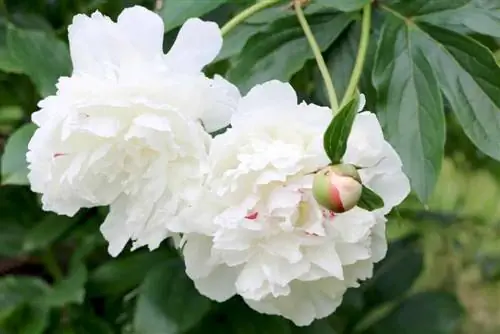
Perennial peonies are generally not one of the plants that prefer division and transplanting. They feel most comfortable when they can stay in their chosen location for decades.
If the perennials still need to be transplanted, the following aspects should first be taken into account:
- Transplant only when plants lose their ability to flower
- Division is absolutely necessary beforehand
- Clumps of plants that are too large usually bloom sparsely
- Division is best done in late summer and early autumn
The right time for division and transplanting
If older plants are to be divided, it has proven to be the best time to choose autumn; Now the perennials have already entered the dormant phase. This can be seen, among other things, in the fact that the foliage gradually dies off. If both division and transplanting take place during this time, the plant is exposed to significantly less stress.
Digging and preparing the plant
In order to optimally divide and transplant, the peony must first be carefully dug up; It is important to remove any leaves that may still be present. The rootstock is now present, which consists of thickened storage organs and can be divided into several sections. Before dividing, it is important to wash the rootstock; This works best with a targeted jet of water. In this way, the hobby gardener can better identify buds and branches; it becomes clear where to cut.
The division process
For all types of perennial peonies, the following aspects must be taken into account when dividing:
- Working with a clean knife
- The blade should be freshly sharpened
- When cutting, be careful not to damage the surrounding bark
The division takes place in different ways - depending on which variety it is. The farmer's peony, for example, has numerous sleeping eyes; These are buds that sit under the bark, you can hardly see them. If severe pruning is carried out, these buds are stimulated to sprout. The farmer's peony is therefore able to sprout from any part of the root. Unlike the noble peonies: Here the hobby gardener has to make sure that each individual root piece has a minimum of three buds. The reason: These varieties mainly only sprout on those buds that you can clearly see - they are reddish in color.
Transplanting peonies
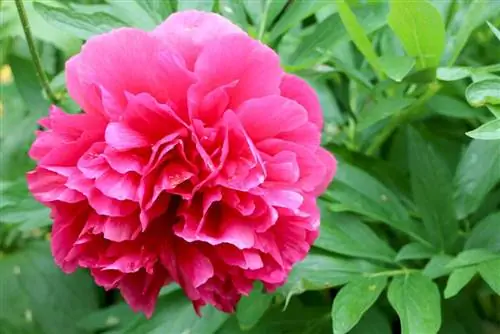
Before planting the root piece, the soil must first be loosened; In addition, optimal drainage must be ensured. When transplanting the individual sections, it is important to ensure that the rhizomes are not inserted too deeply into the soil. Otherwise the peony will be lazy to bloom. The peony is watered well - and then a lot of patience is required. After dividing and transplanting, it takes an average of two years for the plants to bloom profusely again. The hobby gardener has to prepare for this adjustment period.
But if you care for your peony carefully up to this point, cut it if necessary and ensure optimal growing conditions, you will be able to enjoy lush blooms in the garden again after the acclimatization period is over!

